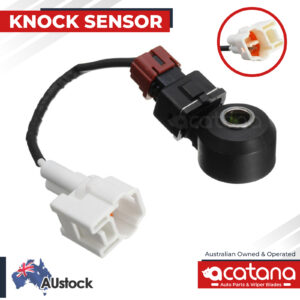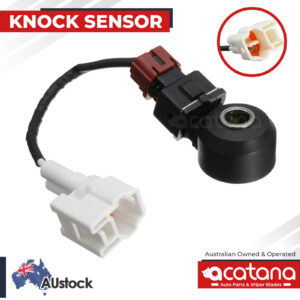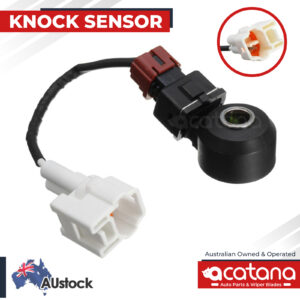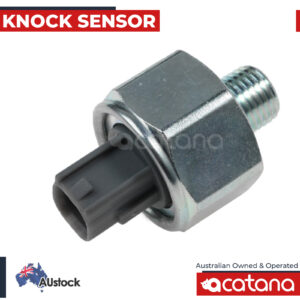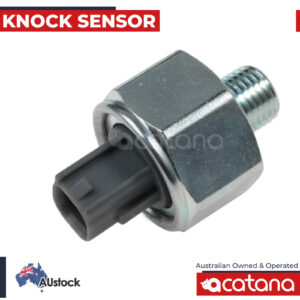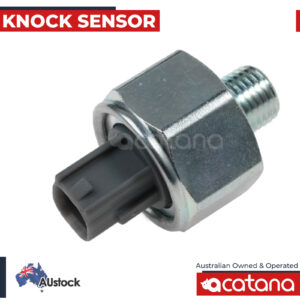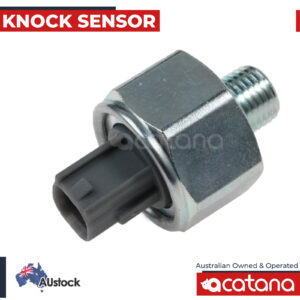Knock Sensors
Shop by Filters
- Air Conditioning & Heating
- Car Care & Detailing
- Car Headlight Bulbs & Globes
- Car Keys & Remotes
- Drive Belt Parts
- Engine Cooling Components
- Fuel Delivery
- Fuel Pumps
- Ignition Systems & Components
- Interior & Body Parts
- New Arrivals
- Sensors
- ABS Wheel Speed Sensor
- Brake Light Switches
- Camshaft Position Sensors
- Crank Angle Position Sensors
- Diff Solenoid Valves
- Freewheel Actuators
- Idle Air Control Valves
- Knock Sensors
- MAF Mass Air Flow Meter Sensors
- MAP Manifold Absolute Pressure Sensors
- O2 Oxygen Sensors
- Oil Pressure Switches
- Sensors by Car Makes
- Suction Control Valve Sensors
- Timing Vacuum Sensors
- Vacuum Solenoid Valves
- Vanos Valvetronic Sensors
- Shop by Vehicles Make
- Windscreen Washer Parts
Ensure optimal engine performance and prevent damage with our selection of high-quality knock sensors. Designed to detect engine knocking or pinging, our knock sensors are engineered to deliver accurate and reliable readings, helping to prevent engine damage and improve fuel efficiency. With a range of options available to fit a variety of makes and models, our knock sensors are the perfect choice for any vehicle maintenance or repair project. Shop now and experience the peace of mind that comes with knowing your engine is running at its best
Showing all 21 results
-
SKU: 30530PNA003-HACM
This knock sensor for Honda Accord 2003 – 2008 CM. Timely replacement of the sensor solves the main problems associated with a faulty part, also can reduce fuel consumption increases torque and upgrades your car. Compatible OEM 30530PNA003, 30530-PNA-003
$20.90$39.00 -
SKU: 30530PNA003-HCEP
This knock sensor for Honda Civic 2002 – 2005 (EU, EP, EV). Timely replacement of the sensor solves the main problems associated with a faulty part, also can reduce fuel consumption increases torque and upgrades your car. Compatible OEM 30530PNA003, 30530-PNA-003
$19.90$39.00 -
SKU: 30530PNA003-HRD20
This knock sensor for Honda CR-V 2002 – 2006 (RD). Timely replacement of the sensor solves the main problems associated with a faulty part, also can reduce fuel consumption increases torque and upgrades your car. Compatible OEM 30530PNA003, 30530-PNA-003
$20.90$39.00 -
SKU: 8961560010-LLX450Knock Sensor for Lexus LX 450 LX450 1996 – 1997 Engine Detonation fits OEM 89615-60010 8961560010In stock
The Knock Sensor for Lexus LX 450 LX450 1996 – 1997 identifies the high-frequency engine vibrations characteristic of knocking and transmits a signal to the ECU. This part is also compatible with these OEM 89615-60010 8961560010
$24.22$49.00 -
SKU: 22060AA070-SF
Replace Sen Assy-Knock for Subaru Forester S10 GT 1997 – 2002 identifies the high-frequency engine vibrations characteristic of Knocking Detonation and transmits a signal to the ECU. This part compatible with OEM 22060-AA070, 22060AA070
$20.49$49.00 -
SKU: 22060AA070-SI
Replace Sen Assy-Knock for Subaru Impreza G10 WRX G11 STi 1993 – 2005 identifies the high-frequency engine vibrations characteristic of Knocking Detonation and transmits a signal to the ECU. This part compatible with OEM 22060-AA070, 22060AA070
$27.90$49.00 -
SKU: 22060AA070-SL
Replace Sen Assy-Knock for Liberty Outback B11 B12 1996 – 2003 identifies the high-frequency engine vibrations characteristic of Knocking Detonation and transmits a signal to the ECU. This part compatible with OEM 22060-AA070, 22060AA070
$27.90$49.00 -
SKU: 22060AA070-OG
Replace Sen Assy-Knock for Subaru identifies the high-frequency engine vibrations characteristic of Knocking Detonation and transmits a signal to the ECU. This part compatible with OEM 22060-AA070, 22060AA070
$20.90$49.00 -
SKU: 8961560010-TAACM20
The Knock Sensor for Toyota Avensis ACM20R ACM 20 2002 – 2003 identifies the high-frequency engine vibrations characteristic of knocking and transmits a signal to the ECU. This part is also compatible with these OEM 89615-60010 8961560010
$24.22$49.00 -
SKU: 8961560010-TAACM21Knock Sensor for Toyota Avensis ACM21R ACM 21 2003 Engine Detonation fits OEM 89615-60010 8961560010In stock
The Knock Sensor for Toyota Avensis ACM21R ACM 21 2003 identifies the high-frequency engine vibrations characteristic of knocking and transmits a signal to the ECU. This part is also compatible with these OEM 89615-60010 8961560010
$24.22$49.00 -
SKU: 8961560010-TCACV
The Knock Sensor for Toyota Camry ACV36R ACV 36 2002 – 2006 identifies the high-frequency engine vibrations characteristic of knocking and transmits a signal to the ECU. This part is also compatible with these OEM 89615-60010 8961560010
$24.22$49.00 -
SKU: 8961560010-TCAHV
The Knock Sensor for Toyota Camry AHV40R AHV 40 2007 2008 2009 identifies the high-frequency engine vibrations characteristic of knocking and transmits a signal to the ECU. This part is also compatible with these OEM 89615-60010 8961560010
$24.22$49.00 -
SKU: 8961560010-TH
The Knock Sensor for Toyota Highlander 2001 2002 2003 2004 2005 dentifies the high-frequency engine vibrations characteristic of knocking and transmits a signal to the ECU. This part is also compatible with these OEM 89615-60010 8961560010
$24.22$49.00 -
SKU: 8961560010-TLC100
The Knock Sensor for Toyota Land Cruiser 100 FZJ 105 FZJ100 1998 identifies the high-frequency engine vibrations characteristic of knocking and transmits a signal to the ECU. This part is also compatible with these OEM 89615-60010 8961560010
$24.22$49.00 -
SKU: 8961560010-TLC70
The Knock Sensor for Toyota Land Cruiser 70 FZJ 75 FZJ75 1992 – 1999 identifies the high-frequency engine vibrations characteristic of knocking and transmits a signal to the ECU. This part is also compatible with these OEM 89615-60010 8961560010
$24.22$49.00 -
SKU: 8961560010-TLC80
The Knock Sensor for Toyota Land Cruiser 80 FZJ FZJ80 1992 – 1999 identifies the high-frequency engine vibrations characteristic of knocking and transmits a signal to the ECU. This part is also compatible with these OEM 89615-60010 8961560010
$23.90$49.00 -
SKU: 8961560010-OG
The knock sensor for Toyota Landcruiser FZJ identifies the high-frequency engine vibrations characteristic of knocking and transmits a signal to the ECU. This part is also compatible with these OEM 89615-60010, 8961560010
$24.22$49.00 -
SKU: 8961560010-TACA20
The Knock Sensor for Toyota RAV4 ACA20 ACA21 2000 2001 2002 2003 RAV 4 dentifies the high-frequency engine vibrations characteristic of knocking and transmits a signal to the ECU. This part is also compatible with these OEM 89615-60010 8961560010
$24.22$49.00 -
SKU: 8961560010-TACA22
The Knock Sensor for Toyota RAV4 ACA22 ACA23 2003 2004 2005 dentifies the high-frequency engine vibrations characteristic of knocking and transmits a signal to the ECU. This part is also compatible with these OEM 89615-60010 8961560010
$24.22$49.00 -
SKU: 8961560010-TACA33Knock Sensor for Toyota RAV4 ACA33 ACA 33 2006 Engine Detonation fits OEM 89615-60010 8961560010In stock
The Knock Sensor for Toyota RAV4 ACA33 ACA 33 2006 dentifies the high-frequency engine vibrations characteristic of knocking and transmits a signal to the ECU. This part is also compatible with these OEM 89615-60010 8961560010
$24.22$49.00 -
SKU: 8961560010-TTACR
The Knock Sensor for Toyota Tarago ACR30R ACR 30R 2000 2001 2002 – 2005 dentifies the high-frequency engine vibrations characteristic of knocking and transmits a signal to the ECU. This part is also compatible with these OEM 89615-60010 8961560010
$24.22$49.00
About Knock Sensor
A Knock Sensor (KS) is a device that detects engine knock or detonation in internal combustion engines. Engine knock is a knocking or pinging sound that occurs when the air-fuel mixture in the combustion chamber detonates prematurely. This can cause damage to the engine and reduce its efficiency.
The knock sensor is typically located on the engine block and it works by listening for knocking or pinging sounds. It sends an electrical signal to the engine control module when it detects engine knock. The engine control module uses this signal to adjust the ignition timing to prevent engine knock from occurring. The ignition timing is the moment when the spark plug fires to ignite the air-fuel mixture in the combustion chamber.
The knock sensor is an important component of the engine control system, as it helps to protect the engine from damage caused by engine knock. By detecting engine knock and adjusting the ignition timing, the engine control module can reduce engine knock and improve engine performance, fuel efficiency and emissions.
In summary, the knock sensor is a device that detects engine knock, and helps the engine control system to adjust the ignition timing to prevent engine knock and protect the engine from damage.
Symptoms of Knock Sensor malfunction
The knock sensor is an important component of a vehicle's engine control system, which detects and reports abnormal engine sounds or knocking vibrations to the engine control module (ECM). If a knock sensor malfunctions, it can cause a variety of symptoms, including:
- Engine Misfires: A faulty knock sensor may cause the engine to misfire or run unevenly, as it may not be able to accurately detect the knocking vibrations.
- Decreased Fuel Efficiency: A malfunctioning knock sensor may cause the engine to run too rich or too lean, which can result in decreased fuel efficiency.
- Illuminated Check Engine Light: A malfunctioning knock sensor may trigger the check engine light to come on, as it sends a signal to the ECM that the engine is not running properly.
- Rough Engine Idle: A bad knock sensor may cause the engine to idle roughly or unevenly, which can be felt through vibrations in the vehicle.
- Engine Damage: If the knock sensor is not functioning properly, it may not detect engine knocking or pinging, which can cause serious engine damage over time.
If you are experiencing any of these symptoms, it is important to have your vehicle inspected by a qualified mechanic to diagnose and fix the problem before it causes further damage to your engine.
Typical faulty knock sensor symptoms.
The symptoms of a faulty knock sensor can vary depending on the severity of the problem, but some common symptoms include:
- Check Engine Light: The most common symptom of a faulty knock sensor is an illuminated check engine light on the dashboard. This light can indicate a range of problems, but if a diagnostic scan reveals a knock sensor code, the knock sensor may be faulty.
- Reduced Performance: A malfunctioning knock sensor can cause reduced engine performance, such as a decrease in power, acceleration, or fuel efficiency. This can also result in engine hesitation or stalling.
- Rough Idle: A faulty knock sensor can cause the engine to run roughly or unevenly when idling, which can be felt through vibrations in the vehicle.
- Engine Damage: If the knock sensor is not functioning properly, it may not detect engine knocking or pinging, which can cause serious engine damage over time.
- Increased Emissions: A faulty knock sensor can cause the engine to run too rich or too lean, which can increase emissions and potentially cause the vehicle to fail an emissions test.
If you are experiencing any of these symptoms, it is important to have your vehicle inspected by a qualified mechanic to diagnose and fix the problem before it causes further damage to your engine.
Where is the knock sensor located?
The location of the knock sensor can vary depending on the make and model of the vehicle, but in general, the knock sensor is usually located on the engine block or cylinder head. It may be located on the top or bottom of the engine block, or on the side of the cylinder head. Some vehicles may have more than one knock sensor, depending on the engine design.
To locate the knock sensor in your vehicle, consult the vehicle's repair manual or speak with a qualified mechanic. They can help you identify the exact location of the knock sensor and provide guidance on how to access it for testing or replacement.
Replacing a knock sensor typically involves the following steps:
- Locate the knock sensor: The knock sensor is usually located on the engine block or cylinder head. Consult the vehicle's repair manual to identify the exact location.
- Disconnect the battery: Before beginning any work on the vehicle, it is important to disconnect the battery to prevent electrical shock or damage to the vehicle's electrical system.
- Remove any necessary components: Depending on the location of the knock sensor, you may need to remove other components to access it. This may include air intake ducts, engine covers, or other parts.
- Disconnect the knock sensor wiring harness: Once you have access to the knock sensor, disconnect the wiring harness from the sensor.
- Remove the old knock sensor: Use a wrench or socket to remove the old knock sensor from the engine block or cylinder head. Be careful not to damage the threads or surrounding components.
- Install the new knock sensor: Install the new knock sensor in the same location as the old one. Tighten it securely, but be careful not to over-tighten and damage the threads.
- Reconnect the wiring harness: Reconnect the knock sensor wiring harness to the new sensor.
- Reinstall any components: If you removed any other components to access the knock sensor, reinstall them.
- Reconnect the battery: Reconnect the battery and start the engine. Check for proper operation of the new knock sensor.
It is important to follow the vehicle's repair manual and manufacturer's instructions when replacing a knock sensor. If you are not comfortable with performing the replacement yourself, it is recommended to consult a qualified mechanic.





